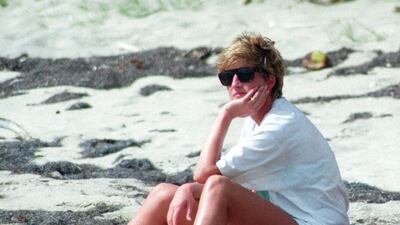Diana, Princess of Wales, once famously noted that there were three people in her marriage to Prince Charles, the third being the prince’s mistress - and now wife - Camilla Parker Bowles.
But she was wrong; there were actually hundreds of millions of people in their union, since the whole world seemed captivated by the fairytale-gone-wrong that lasted from a royal wedding in 1981 to their 1996 divorce. And as the 20th anniversary of her death on August 31 approaches, the British public's insatiable appetite shows no signs of abating.
On Sunday, Channel 4 will show Diana in Her Own Words, a programme featuring video clips made in 1992-3 of the princess talking about her life and marriage.
Although some extracts have been aired before, with NBC broadcasting short clips from them in 2004, British audiences have never legitimately seen them. The tapes were recorded at Kensington Palace by speech coach Peter Settelen, who was hired to help Diana present her case after the royal couple separated in 1991.
In a series of remarkably candid revelations, Diana talks in excruciating detail about how she was courted by Charles, the couple’s sex life, her love for a royal bodyguard who she wanted to run away with, and how the presence of Camilla Parker Bowles was always there in the background.
The tapes were discovered by police in 2001 while they were searching the home of Diana’s former butler Paul Burrell, who was accused of stealing personal items from the princess after she died in 1997 but subsequently acquitted following an intervention from Queen Elizabeth II.
Charles and Diana’s relationship was long played out under the media spotlight, from the early days of their courtship, when Diana was subjected to the intense press attention that has plagued the royals ever since, through to their engagement and a wedding in 1981 that was watched by an estimated global audience of 750 million. Her death in a car accident in Paris was a seismic news event and two billion people watched her funeral, making it one of the most watched events in history.
During her unhappy marriage, Diana became adept at manipulating the pack of reporters and photographers who congregated around her, feeding titbits to certain favoured journalists and allowing herself to be photographed in ways that would endear her to the public at Charles’s expense; most notably in when she posed alone in front of the Taj Mahal in 1992.
This came to a head in 1995 when she notoriously gave an interview to Martin Bashir for the BBC’s Panorama programme and opened up about her unhappy marriage, confessed to an affair with her sons' riding instructor James Hewitt, and spoke of wanting to be the “queen of people's hearts”.
Despite this undoubted predilection for co-opting the media, Diana's friends and family have rallied round to attack the Channel 4 programme.
“This doesn’t belong in the public domain,” Rosa Monckton, a confidante of Diana’s, told the Guardian. “It is a betrayal of her privacy and of the family’s privacy. I certainly don’t think they should be broadcast. The [tapes] should be dispatched to the young princes.”
Diana’s brother, Earl Spencer, is said to have implored the network in writing not to show the documentary. But Channel 4 have robustly defended the broadcast, saying: “The excerpts from the tapes recorded with Peter Settelen have never been shown before on British television and are an important historical source. This unique portrait of Diana gives her a voice and places it front and centre at a time when the nation will be reflecting on her life and death.”

